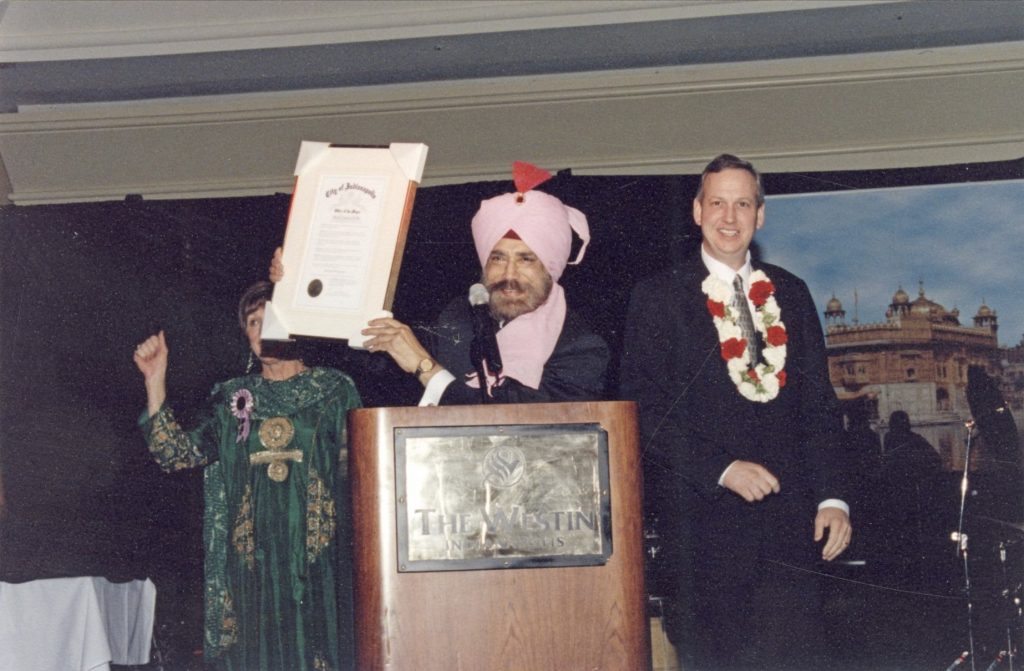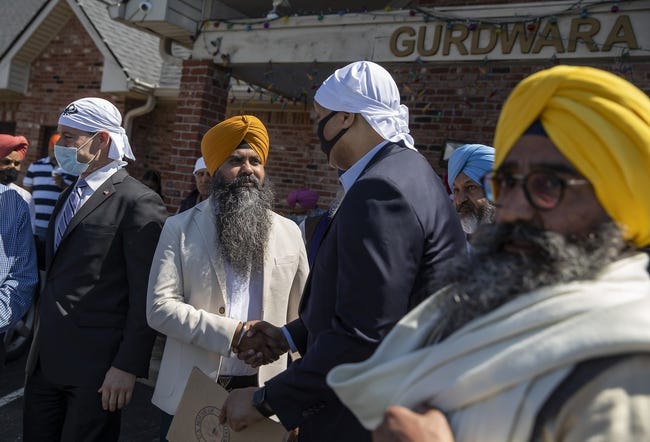Sikhism is a distinct religion and the fifth-largest in the world, with a following of over 35 million scattered across the globe. It originated in Punjab in northern India. The first Sikhs to arrive in the U.S. immigrated to the West Coast region, where they originally worked as railroad laborers, lumbermen, and later agricultural workers. The earliest handful of Sikhs arrived in Indiana sometime in late the 1950s.

By September 1967, there were fewer than 15-to-20 individuals who came from the entire Indian subcontinent living in Indianapolis. Among them were Ramesh Patel, a structural engineer at Owen McKinely; Avinash Patel, an engineer at ; the Sangars, a school teacher and his family from Pakistan; Ramesh Shah, a research scientist at ; and Kanwal Prakash (KP) Singh, senior planner in the Indianapolis Department of Planning. At the time, Hoosiers had not seen a Sikh or had any significant contact with Sikhs. Most Hoosiers initially did not warm up to the distinct appearance of Sikhs with their faith-mandated uncut hair, turbans, and beards. They were and continue to be confused with Middle East .
In the decades that followed (1970s-1990s), many more Sikhs and Asians, as well as other ethnic immigrants arrived in Indiana. Since then, 1000s of Asians and Sikhs relocated from both the East and West Coast into the Midwest to make Indiana their home. By 2020, more than an estimated 15,000 Hindu families and 5,000 Sikh families lived across Indiana, most of them in Central Indiana.
The Sikh faith has its monotheistic doctrine, precepts, spiritual traditions, and proud history and heritage. It is neither a branch of nor an offshoot of Islam. Sikhism is among the youngest major religions, and its foundation was laid by Guru Nanak (1469-1538) and nurtured nine Gurus (Enlightened Teachers) through October 1708. Before his passing, the last Sikh Guru Gobind Singh commanded Sikhs henceforth to embrace and honor Sri Guru Granth Sahib, the Sikh Holy Scriptures as their Eternal Living Guru of the Sikhs.
The original Sikh scripture was compiled by the Fifth Guru, Arjan Dev, and installed at Harmander Sahib (popularly known as the Golden Temple, the holiest shrine and the St. Peter’s and Vatican of the Sikh faith) at Amritsar, India, on August 30, 1604. It was updated by the 10th Guru Gobind Singh and declared as the Eternal Living Guru of the Sikhs in October 1708. Sri Guru Granth Sahib (SGGS) is always placed on an exalted Canopied Throne draped in majestic jeweled silks as the crowning element in the congregation halls of the Sikh Gurdwaras (places of worship). Guru Granth Sahib is considered the embodiment of the spirit of the 10th Sikh Guru. It is an ecumenical scripture: besides the contributions of six Sikh Gurus, SGGS enshrines the compositions of mostly contemporary 30 Hindu, Sikh, and Muslim saints of different traditions.

The entire scripture, with around 5,894 compositions enshrined in 1430 pages, is written in Punjabi (Gurumukhi) language and in poetry, and a majority of the scriptural compositions are keyed to 31 distinct designated musical measures known as Ragas, in which these sacred hymns are to be sung. The compositions reveal a diversity of languages and styles and syntax of many regions of India that also include Persian. The entire Guru Granth Sahib reverberates with a unifying philosophy and universal message: Oneness of God, the Father and Mother of all Sentient Beings; all humanity as One Race carrying the same Divine Light and thus Equality, Justice, and Dignity of people of every race, nationality, faith, culture, gender, association, and tradition. The three pillars of Sikh faith: Remembering Immaculate Eternal Truth, the Compassion Wonderful God and Creator of the limitless and unfathomable universe; engaging in righteous labor and truthful living; and sharing and serving others without distinction as the true mandate of the faith. Later Gurus added the right to bear arms to combat tyranny and violent outrage of tyrannical and religiously zealot rulers against fellow beings of other faiths.
There are at least seven recognized Gurdwaras (Sikh places of worship) in central Indiana, and others in Merrillville, Mishawaka, Fort Wayne, and Evansville. The is the oldest and largest congregation that has been serving the community since 1969. It was formalized in the early 1970s and remains an undisputed leader in the Sikh community outreach efforts and commitment. The Sikh Satsung is among the celebrated and foremost community anchors. There are smaller congregations in college towns and worship in people’s homes, clubhouses, and community buildings, which was the case in Indianapolis until the Sikh Satsung Gurdwara opened in southeast Indianapolis in 1999.

At the Sikh Gurdwara everyone takes their shoes off and covers their heads with a scarf regardless of faith, gender, ethnicity, or the purpose of the visit. Scarves are available at the entrance or one may bring one’s own. In the sanctuary, Guru Granth Sahib is installed with great traditional honor and dignity, much like on a royal throne. The congregation members walk up to it and touch their forehead to the floor and place monetary offerings and then rise to sit on either side of the central path leading to the Spiritual Throne. Sikh musicians perform on a low platform with their musical instruments and sing sacred hymn selections from the Sri Guru Granth Sahib. At certain times during the worship service, the audience is invited to participate and sing along. At the end of the formal worship, Sikhs rise for Ardaas (to offer a prayer and petitions from the congregation, and for the well-being of the entire Creation) to the Almighty for his myriad blessings and compassionate intercessions.
A Hukamnama (sacred message by opening the Scriptures at random) is read with great solemnity and interpreted by the Head Granthy (Sikh religious leader). The traditional whole-wheat flour pudding is distributed to the entire congregation, and everyone moves to the Langar Hall for a community vegetarian lunch, which included vegetables in curry style, lentils more like a soup, rice, unleavened flat bread, salad, rice pudding or some other Punjabi sweet, and bottled water, and a robust fellowship time and exchange of ideas. Dressing modestly and in comfortable clothes is a sensible idea, since for worship in the sanctuary and during vegetarian community meal (Langar) everyone is seated on a carpeted floor and carpet runners.
Together the Gurdwaras in Indianapolis, Greenwood, Fishers, Plainfield, and others meet the spiritual, cultural, and societal needs of the Indy Hoosier Sikhs. To that end, Sikh leaders have connected with all city, state, and national leaders since their arrival in Indianapolis.
Over the years, Indianapolis-area Gurdwaras have had to address issues regarding Sikh turbans and beards in relation to Indiana driver licenses, discrimination and harassment in workplaces, bullying in schools and colleges, and wrongful associations and stereotyping of Hoosier Sikhs because of their appearance.
In recent decades, the Gurdwaras have added Punjabi language classes, summer youth camps with martial arts training, scriptural reading, and Sikh music; critical civic education and insights about interfaith engagement that address major Sikh concerns, opportunities, responsibilities, and a commitment to support major worthy causes in the community. These institutions provide opportunities for networking with other Sikh organizations across the nation and to support disaster relief efforts across the world.
The Gurdwaras also offer a number of speaking and visual presentations. Several leaders, such as Indianapolis mayors , , and ; Governor Mitch Daniels; state legislators; U.S. representatives Susan Brooks and Andre Carson; law enforcement officials; and many faith and cultural leaders and cultural guests have visited the Sikh Gurdwara in since it opened in February 1999. Media coverage of special celebrations, visits of honored guests to the Gurdwaras, and the annual Sikh Parade in downtown Indianapolis also add to Sikh community awareness efforts.
In addition, Gurdwara members regularly participate in local and state events. Gurdwara members join others from across the state, including visitors from diverse religions, as a part of the tour of sacred places organized by the , , area schools, and other groups. They have pursued the idea of mainstreaming their concerns through education and diverse vigorous involvements in civic, multicultural, interfaith, national and international events and projects: Interfaith Prayer Services at , Carmelite Monastery, Tibetan Mongolian Buddhist Cultural Center in Bloomington, St. Luke’s United Methodist Church, Interfaith Chautauqua at Greensburg High School, and Bicentennial at the Roofless Church in New Harmony; presentations at Indiana State University, , and IUPUI, Brebeuf and Franklin Central High Schools; fundraisings for hurricanes, earthquakes, and tsunamis through the Red Cross; hunger initiatives of , Midwest Food Bank, and ; participation and displays at the ; Asian American Alliance’s Asian Fest and Race for All races; , Center for Interfaith Cooperation’s Indy Festival of Faiths and Interfaith Ambassador of the Year Banquet; 9/11 Community Service Fair on Monument Circle; a beautiful Friendship Lunch at the Indiana Statehouse; and hundreds of other large and small events over the past half a century.
This strategy of involvement works to dispel problems of discrimination and hate. Despite all of these efforts, four members of the Indianapolis Sikh faith fell victim to a mass shooting on April 15, 2021, at one of the city’s facilities near the . Although his exact motive remains unknown, the shooter, who was one of eight people who died in the incident, reportedly had frequented white supremacist websites.

Help improve this entry
Contribute information, offer corrections, suggest images.
You can also recommend new entries related to this topic.
